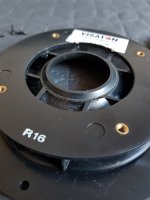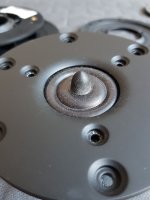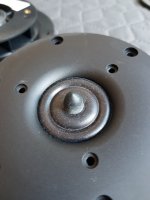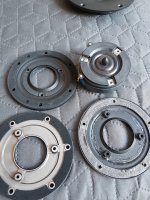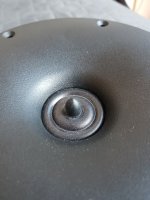Does anyone here know whether the Scan Speak Ringradiator Waveguide also fits the Peerless/Vifa XT25BG60-0?
If not , would it be possible to redesign the elliptic waveguide for fitting the XT 25?
Kind regards,
Eelco
If not , would it be possible to redesign the elliptic waveguide for fitting the XT 25?
Kind regards,
Eelco
Boden, I had XT25, 7000, 6600, 7100 in hands, they all have same interface to faceplate. I fitted them to modified WG148R. From that I conclude also Augerpro waveguide would fit these tweeters.
Boden, I had XT25, 7000, 6600, 7100 in hands, they all have same interface to faceplate. I fitted them to modified WG148R. From that I conclude also Augerpro waveguide would fit these tweeters.
Is the outer diameter of the XT25 suspension the same as with the R7000 or D6600?
Yes.
Measurements:
7100 and 7000 faceplates, diameter of opening for dome 39mm
WG148R diameter of throat 38.2mm. This is very tight fit, and it is better to chamfer the throat edge 45deg, ~0.5x0.5mm. It is very easy.
There are images in the attachment, XT25 in WG148R, XT25 + faceplate 6600, XT25 + faceplate 7100, photo of tweeter + faceplates, and WG with modified rear side.
I did not measure 6600, 7100 or 7000 outer diameter of suspension directly because I do not have them available.
Measurements:
7100 and 7000 faceplates, diameter of opening for dome 39mm
WG148R diameter of throat 38.2mm. This is very tight fit, and it is better to chamfer the throat edge 45deg, ~0.5x0.5mm. It is very easy.
There are images in the attachment, XT25 in WG148R, XT25 + faceplate 6600, XT25 + faceplate 7100, photo of tweeter + faceplates, and WG with modified rear side.
I did not measure 6600, 7100 or 7000 outer diameter of suspension directly because I do not have them available.
Is the outer diameter of the XT25 suspension the same as with the R7000 or D6600?
Attachments
Last edited:
Ok then! I have a few more augerpro waveguides for the Scan tweeters, see group buy link in my signature.
Hello Brandon and others,
I downloaded the SS Ringradiator 6" wg file, and imported it in Zortrax Suite. Once openend in Zortrax Suite. printing time indicated is 18 hrs 42 mins.(for a Z 300) , whereas the filament is Z-Glass.
Are the printing time and Z-Glass in the original file, or is that a Zortrax calculation and suggestion? If so, what material would you gentlemen then recommend?
Best regards,
Eelco
I downloaded the SS Ringradiator 6" wg file, and imported it in Zortrax Suite. Once openend in Zortrax Suite. printing time indicated is 18 hrs 42 mins.(for a Z 300) , whereas the filament is Z-Glass.
Are the printing time and Z-Glass in the original file, or is that a Zortrax calculation and suggestion? If so, what material would you gentlemen then recommend?
Best regards,
Eelco
How can I best use an EQ to make the boost by the WG flat again?
I'm going to use the SB26 with the 6" WG.
I'm going to use the SB26 with the 6" WG.
Sorry for the absence, working a ton the last few months. But the good news is I've started a new website somasonus.net to host all my DIY stuff. It's barren right now, but I have posted the best of the waveguides with downloadable CAD files for 3D printing or CNC. Let me know if anything renders weird on the website, it really changes depending on what device I'm on.
Last edited:
How can I best use an EQ to make the boost by the WG flat again?
I'm going to use the SB26 with the 6" WG.
You can use a shelf filter, or sometimes just the typical high pass filter can flatten it out if you have Fc at the right frequency.
How can I best use an EQ to make the boost by the WG flat again?
I'm going to use the SB26 with the 6" WG.
Do you really want it flat, on axis? Think again... the perceived sound balance corresponds to the power response, not the on-axis response. The power response is the integrated sound power radiated into the room. The power response does not change as much as the on axis response when you add a waveguide to a tweeter.
Anyone familiar with wavelet analysis? What parameters would one use for analyzing waveguides?
Hi,
Maybe you could have a look there.
HTML:
http://elias.altervista.org/html/Wavelet_software.htmlM
That doesn't really tell me anything about what parameters to use. Here is pic of what I mean, might take Soundeasy users to help me out:


See the manual, Chapter 16.3.
Time step is the time scale used, based on sample rate. Range refers to the amplitude representation.
Higher scale values yield more frequency resolution at the expense of time, lower values yield the reverse.
Try a higher scaling when looking at high-frequency behavior.
Time step is the time scale used, based on sample rate. Range refers to the amplitude representation.
Higher scale values yield more frequency resolution at the expense of time, lower values yield the reverse.
Try a higher scaling when looking at high-frequency behavior.
Last edited:
Huh. This is new to me. I thought, because of the boost visible in the measurements, one should make it flat on-axis. Isn't the same done with a bigger horn?Do you really want it flat, on axis? Think again... the perceived sound balance corresponds to the power response, not the on-axis response. The power response is the integrated sound power radiated into the room. The power response does not change as much as the on axis response when you add a waveguide to a tweeter.
Last edited:
Huh. This is new to me. I thought, because of the boost visible in the measurements, one should make it flat on-axis. Isn't the same done with a bigger horn?
Which measurements? You need to understand what the measurements mean, and how to interpret them. If in doubt, do some experiments to learn how the results from a microphone correlate with what your ears tell you.
What do you guys think of this? 🙂
Simulated the response via the diffraction tool and SPL tracing the 5" WG for the SB26ADC. Woofer is the SB17NBAC-4, sub CSS SDX10.
(I can't seem to plug images directly)
Simulated the response via the diffraction tool and SPL tracing the 5" WG for the SB26ADC. Woofer is the SB17NBAC-4, sub CSS SDX10.
An externally hosted image should be here but it was not working when we last tested it.
Concept - Album on Imgur(I can't seem to plug images directly)
Last edited:
Interesting. I have a 6.5" on tap for the SB26 for those lower crossover frequencies. Maybe you could trace the factory SB26ADC curves and see what improvement you already have over that?
- Home
- Loudspeakers
- Multi-Way
- Open source Waveguides for CNC & 3D printing!
